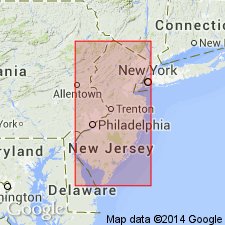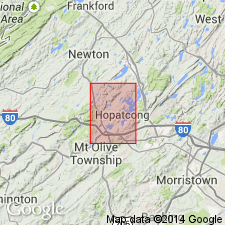
- Usage in publication:
-
- Green-pond-mountain conglomerate
- Modifications:
-
- Original reference
- Dominant lithology:
-
- Conglomerate
- Sandstone
- AAPG geologic province:
-
- Piedmont-Blue Ridge province
Summary:
Pg. 127. Green-pond-mountain conglomerate. Usually a bright-red sandstone, rather fine-grained, imbedding large water-worn pebbles, most commonly white quartz; sometimes the paste is more argillaceous. Constitutes Long Pond, Raffenberg, and Green Pond Mountains. Age is Silurian. [In some subsequent reports the conglomerate of Green Pond Mountain was wrongly designated as Potsdam sandstone.]
Named from Green Pond Mountains.
Source: US geologic names lexicon (USGS Bull. 896, p. 872); supplemental information from GNU records (USGS DDS-6; Reston GNULEX).

- Usage in publication:
-
- Green Pond Conglomerate*
- Modifications:
-
- Age modified
- AAPG geologic province:
-
- Piedmont-Blue Ridge province
Summary:
The Green Pond Conglomerate in the Green Pond syncline is correlative with the Shawangunk Formation of Early and Middle Silurian age, which crops out to the northwest along Kittatinny Mountain. Age is Early(?) and Middle(?) Silurian.
Source: GNU records (USGS DDS-6; Reston GNULEX).
For more information, please contact Nancy Stamm, Geologic Names Committee Secretary.
Asterisk (*) indicates published by U.S. Geological Survey authors.
"No current usage" (†) implies that a name has been abandoned or has fallen into disuse. Former usage and, if known, replacement name given in parentheses ( ).
Slash (/) indicates name conflicts with nomenclatural guidelines (CSN, 1933; ACSN, 1961, 1970; NACSN, 1983, 2005, 2021). May be explained within brackets ([ ]).

